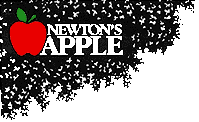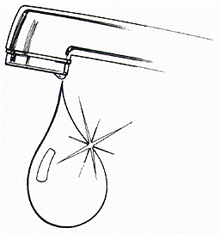
 Show #905
Show #905
 Show #905
Show #905
Where does sewage go?
Clean water is one of our most precious natural resources. Yet every time we flush a toilet, pour oil down the drain or clean with strong household chemicals, we contaminate our supply. Before wastewater can be released into our waterways, it must go through a process called sewage treatment to be decontaminated.
A network of underground pipes collects the millions of gallons of waste material created by a community. When the waste and water arrive at the sewage treatment plant, large objects are filtered out with screening devices. The flow of the wastewater is then slowed to allow the sludge to settle. Oils and grease are skimmed off the surface of the effluent sewage. The effluent is then treated with chlorine to kill specific microorganisms that cause disease before the water is returned to the waterways. This process is called primary treatment. Unfortunately, this treatment only removes about 50 percent of the pollutants found in wastewater and most sewage treatment plants must use a second stage of treatment.
In secondary treatment, effluent and sludge are exposed to oxygen in an aeration tank. Here, valuable microorganisms consume the organic matter and even some of the poisonous or toxic materials. Then chlorine is added before the water is released into the waterways.
Sludge from both primary and secondary treatments is pumped into oxygen-free digestion tanks and then dried. This processed sludge is often used as a fertilizer or as fuel. Sludge contaminated with toxic material must be incinerated or buried in a landfill.
One way or the other, water returns to the environment. That is why sewage treatment is so important.
Sewer--A subterranean conduit to carry off sewage and sometimes surface water, like rain.
Sludge--Precipitated solid matter produced by water and sewage treatment processes.
Microorganisms--An organism of microscopic or ultramicro-scopic size. While some promote disease and must be killed by chlorine in sewage treatment, others are necessary in removing organic matter and some toxic materials from liquid sewage.
Effluent--Waste material, such as liquid industrial refuse or sewage, discharged into the environment.
Sewage--Refuse liquids or waste matter carried off by sewers.
Settle Down!
Find out how sediment forms and deposits.
Main Activity
You will observe what happens when different sized particles are settled in water. You can create a model sedimentation tank to see how sludge and effluent are separated.
 Materials:
Materials:
1. Mix the dirt and water in a bucket. Fill the baster with the mixture from the bucket and put it into cup #1. Record your observations.
2. Put the sand, pebbles and rocks into the bucket. Fill the cup marked #2 from the bucket and record your observations.
3. Pour salad oil into the bucket. Fill the baster from the middle of the mixture in the bucket and place its contents into cup #3. Take a baster full from the top of the bucket and put it in cup #4. Observe cups #3 and #4.
4. Without mixing the contents of the bucket, pour the remainder of the mixture into the aquarium. What happens after an hour? Five hours? One day? One week?
Questions
1. What was different about each sample taken?
2. What did you notice about the samples in each cup? How would you remove the oil from the mixtures in #3 or #4?
3. Can you remove the dirt from the bottom of the aquarium without mixing it with the liquid on top?
4. How are your observations similar to what happens in ponds and streams in nature?
![]()
![]()
Take an inventory of the products in your home. Which ones are poisonous
or toxic to plants and animals? Contact a sewage treatment plant to find
out how these products affect the waste streams at the plant. Try to find
some alternative products that are not harmful to the environment.
![]()
![]()
Adopt a stream in your community (see the Izaak Walton League in the Resources
section). Learn about the chemicals used on lawns or farms in your neighbor-hood.
Determine how these fertilizers affect your stream. Are there any other
sources of pollution that could harm it?
![]()
![]()
Find out how many gallons of water your toilet, bathtub, washing machine
and dishwasher hold. Record the number of times each one is used in a day.
Does your family use more water on weekdays or on weekends? List ways your
family could safely conserve water.
![]()
![]()
Take a field trip to your local waste treatment plant. Investigate how
sludge from waste treatment is stored or recycled. Is it put in a landfill,
used for fertilizer or incinerated? Find out if and why these ways are
controversial.
Tapes of this episode of Newton's Apple and others are available
from GPN for only $24.95.
Please call 1-800-228-4630.
For information on other Newton's Apple resources for home and school,
please call 1-800-588-NEWTON!
WE ENCOURAGE DUPLICATION FOR EDUCATIONAL USE!

 Newton's Apple is a production of KTCA Twin Cities Public Television. Made
possible by a grant from 3M.
Newton's Apple is a production of KTCA Twin Cities Public Television. Made
possible by a grant from 3M.
Educational materials developed with the National Science Teachers Association.